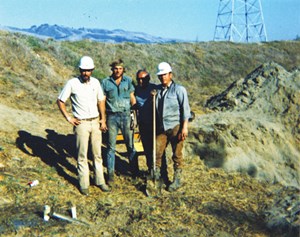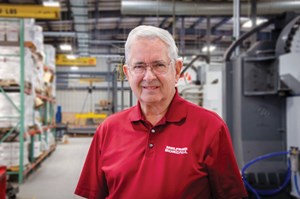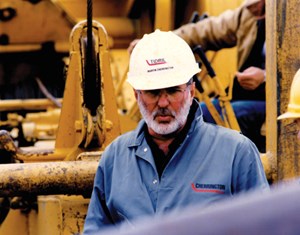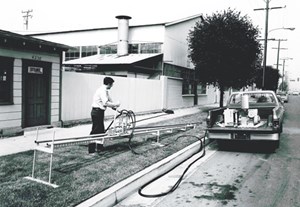November 2019 Vol. 74 No. 11
Features
Melsheimer, Cherrington Named Inaugural Pioneers of the HDD Hall of Fame
Ceremony, Additional Activities Planned for the First-Ever HDD Reunion
Always the inventor, Dick Melsheimer was simply trying to help a contractor friend solve a utility installation challenge. Martin Cherrington, another innovator, knew that there had to be a better way to cross a river with a pipeline than by traditional means.
Regardless of their motivations, these visionary men invented horizontal directional drilling and helped develop it into the game-changing technology that it is, radically and forever modifying the construction approach to underground utilities infrastructure.
Underground Construction magazine, in conjunction with the HDD Reunion, is proud to name industry pioneers Cherrington and Melsheimer as the initial inductees into the HDD Hall of Fame. The formal induction ceremony will be held during the HDD Reunion Reception at the Underground Construction Technology (UCT) International Conference & Exhibition on Jan. 29. The HDD Reunion is being held in conjunction with UCT at the Fort Worth Convention Center, Fort Worth, Texas, with educational sessions and activities planned Jan. 28–30. There will also be a special interactive session with Melsheimer and Cherrington, when they will engage in conversations with the audience.
The HDD Reunion, founded by industry personnel, will allow
older or retired drillers to converse with current operators to swap stories, compare and contrast early equipment with modern tools, share experiences and renew and sustain old friendships. Those new to the industry will find the information and knowledge they gain extremely useful in their current jobs. The event is for all those who have participated in the industry throughout the years including contractors, owners, engineers and manufacturers no matter the rig size, from jumbo to mini units. In short, the purpose of the reunion is to celebrate the comradery that is HDD.
UCT was the primary event that embraced HDD and continues to do so today. Contractors and related personnel still flock to UCT to learn from the industry’s most extensive HDD educational program, “kick the tires” on new equipment and network with their peers.
Founding Sponsors are making this historic event possible with their exclusive support of the HDD Reunion. Participants will be able to find these stand-out companies on the exhibit hall floor and at the reunion reception.
While there will be a $25 charge to attend the reunion, attendees get their money back and much more by contacting any of the founding sponsors for a special registration code. That code will provide free exhibit hall passes and discounts for the primary HDD Educational program at UCT. Attendees will also be treated to complimentary beverages and hors d’oeuvres at the HDD Hall of Fame Reception and a custom-designed HDD Reunion T-Shirt.
Dick Melsheimer
When someone talks about the HDD segment of the trenchless technology industry, undoubtedly the name Dick Melsheimer is mentioned. For over 50 years, he has used his mechanical genius to innovate tools and technologies for installing underground utilities. Dick’s father, Fred Melsheimer, founded Melfred Borzall (then called Melfred Welding & Manufacturing), but it was Dick who truly pioneered and advanced the HDD industry.
In the 1960s, Melsheimer developed the concept, equipment and tools for the “cut-and-bore” method, using horizontal earth boring to facilitate the rapid installation of underground gas and electrical utilities. This was the original horizontal directional drilling method using a pulling swivel and product pipe connected to a backreamer, which would cut as it was pulled back towards the boring machine. In the early 1970s, Melsheimer led a team that developed the first electronic walkover locator for tracking the drill bit underground.
Melsheimer’s innovations also greatly improved the safety of underground boring. In the 1960’s, he developed insulated attachments and tools that greatly reduced the electrical hazards of slurry boring. In the late 1990s, he led the development of the Zapalert electrical strike alarm, which became a standard feature on all horizontal directional drills worldwide.
It would turn out that Melsheimer’s early patents, which he kept open in hopes others would continue to build off his initial work, also proved instrumental in defending the industry against a major threat in late 1990s. L.K. Comstock & Co. had purchased an HDD patent and began efforts, including filing lawsuits, to stop alleged infringements of its patent rights. Comstock was requiring contractors to negotiate a license and royalty arrangement and even sued a manufacturer.
Melsheimer realized the threat to the growth of the HDD industry. He produced many “prior art” records (photos, catalogs, drawings, etc.) that showed Melfred Borzall had developed this method and demonstrated the process to contractors decades earlier. He aided court cases, defending contractors against the patent infringement allegations. Comstock suddenly settled pending court cases (details were private but apparently in favor of the contractor defendants) and no further lawsuits were filed before the patent expired. There is no doubt that Melsheimer’s efforts helped thwart a serious threat to the growing HDD industry.
Dedicated to keeping HDD technology moving forward, Melsheimer has played an important role in multiple industry associations. Melsheimer was a charter member of the Horizontal Earth Boring Council of the Equipment Manufacturer’s Institute (now known as the Underground Equipment Council of AEM). Melsheimer was a key contributor to the Council’s early activities, including development of safety signs for underground equipment. He was also a charter member of the North American Society for Trenchless Technology (NASTT).
To this day, when Melsheimer sees a contractor tearing up a road to install some sort of utility, he stops to ask the crew, engineers, and inspectors why they are doing it this way, and makes sure they are aware of the benefits of horizontal directional drilling. He’s not trying to sell anything. He does it because he is passionate about getting utilities underground in the most non-invasive, productive and safest means possible.
Martin Cherrington
For over 50 years, Martin Cherrington has created horizontal drilling technologies and methodologies through ownership of his HDD contracting entities Titan Contractors (1964–1979) and Cherrington Corporation (1984–2009) and HDD manufacturing entity Tidril Corporation (1976–2004). He is credited with accomplishing the first HDD river-crossing in 1971 and first frac resistant river- crossing in1978.
Cherrington has been granted 27 U.S. Patents relating to directional drilling, and is a recipient of the NASTT Hall Of Fame Award. His work ethic has been described as an incredible sense of not knowing when to stop.
Cherrington’s fascination with the concept of HDD started in the 1960s when he was working for a utility installation company in Los Angeles. While out on a job, he witnessed another company doing some work nearby, using a hand-held air drill for a gas line installation. That experience inspired Cherrington to further develop the concept of guided drilling and take it another level.
In 1964, Cherrington founded Titan Contractors and built his own drill rig. Though a shell of what rigs are like today, it was still a functional, similarly shaped machine. He initially obtained contracts consisting largely of road crossings with the Sacramento Municipal Utility District. Since electronic tracking was not yet developed, Cherrington’s crews used hand-held air drills to check the bore path – essentially early potholing that is performed today by vacuum excavators.
Cherrington continued to develop the process. Perhaps his biggest initial success that also drove the fledging industry’s future growth was his first river crossing. Pacific Gas & Electric approached Cherrington about using his new technology to drill roughly 500-feet under the Pajaro River to install a 4-inch gas line. The project was a success, and word quickly spread regarding the capabilities and opportunities of HDD. •

HDD Reunion, Hall of Fame Schedule
Tuesday, Jan. 28
- HDD Educational Program @ UCT including the annual HDD Contractors Roundtable
- Exhibition with HDD manufacturers/suppliers
Wednesday, Jan. 29
- HDD Educational Program @ UCT
- HDD Hall of Fame Pioneers interactive panel
- HDD Reunion Networking Reception
- Formal Introduction of 2020 HDD Hall of Fame Class
Thursday, Jan. 30
- HDD Emerging Technologies @ UCT
For more information, go to uctonline.com, hddreunion2020.com or send an email to hddreunion2020@gmail.com.
Industry Support Soars for HDD Reunion, Hall of Fame
To make this special HDD Reunion and HDD Hall of Fame possible, leading HDD companies have stepped forward to become Founding Sponsors and support their friends and customers. You will find all these companies in the UCT Exhibit Hall.
Founding Sponsors include:
JT Miller
Tulsa Rig Iron
Derrick Corporation
LaValley Industries
Century Products
American Augers
INROCK Drilling Systems, Inc.
TT Technologies
Railhead Underground Products
LaValley Industries
Right Turn Supply
Sharewell HDD
Brownline
Hard Rock Directional Drilling
Mud Technology International
Bell Trenchless Consulting
Underground Construction Magazine / UCT
To become an exhibitor and HDD Reunion Founding Sponsor, contact Jenna Rutan, jenna.rutan@gulfenergyinfo.com, (713) 520-4413.







Comments